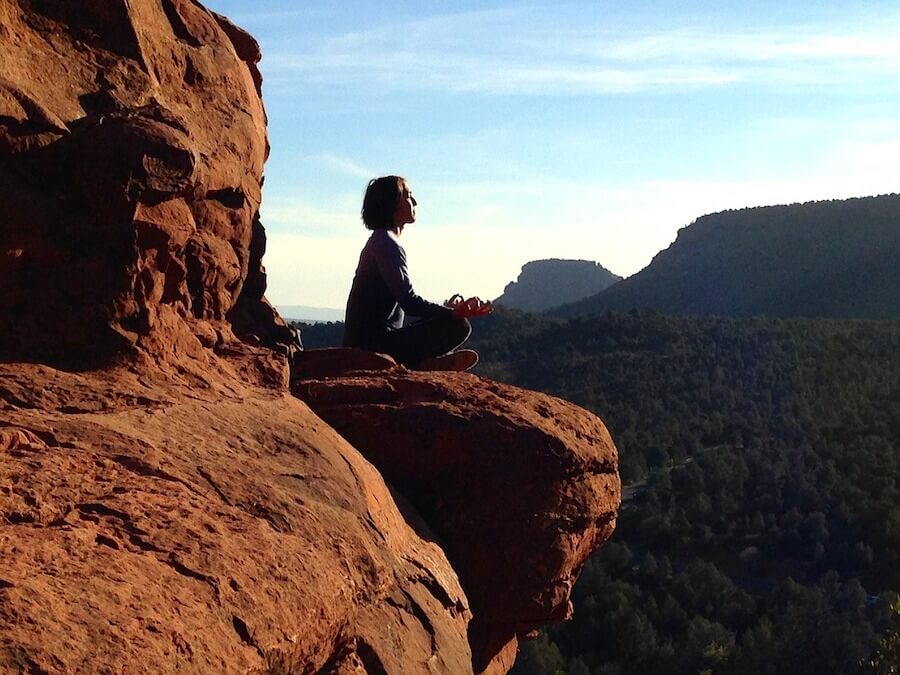So you think you can’t meditate. I hear you.
But you can. Absolutely.
And meditation isn’t as difficult as you might think. Sure it can be a journey for the rest of your life, and can even be challenging sometimes, but it isn’t difficult.
In fact, there are many misconceptions about meditation. Meditation really is key to so many extraordinary aspects of our life.
Through meditation you can unleash your inner potential to live life to your fullest.
And through meditation we can also manifest our own destiny.
Perhaps you think your mind doesn’t stop chattering, so you can’t mediate. O maybe you just don’t know how to get started?
Or maybe it’s finding the time to meditate that stops you?
Whatever it is that’s holding you back, recognise it as a choice. You can choose to meditate and the objections will fall away.
And in this article we’ll dig into how to get started meditating.
Table of Contents
The Beginning of Your Meditation Practice
There are various ways to meditate and infinite personal variations. But is there a wrong way to meditate? And how do you know if you’re doing it right?
Well, there’s no ‘right’ or ‘wrong’ way. But there are ways that will bring you to a deeper state of meditation or not, as the case may be.
So when you’re just starting out, be open to experimenting and trying out different methods.
Maybe you want to meditate on a particular question or perhaps to reconnect with your true essence and experience all the benefits that come with meditation by exploring mindfulness meditation.
And if you’re asking yourself how long it takes to learn mindfulness meditation, you might be surprised to know that you can start feeling the benefits very shortly after beginning a regular practice.
In the beginning you may wonder if you should set a timer while meditating. This can be a useful way to start out because you can then forget about the time and concentrate more on your meditation. In the beginning, start out with short sessions and gradually build them up as you get more practiced.
You can also try exploring guided meditations or transcendental meditation.
With practice, you’ll begin to find your own prefferred way to meditate. But in the beginning there are a few pointers that can help you start.
So here they are, in no particular order.
Once you recognise these points, maybe you’ll feel more confident to start meditating right away.
I Can’t Meditate! 6 Myths Debunked
Some of the common misconceptions about meditation and why they aren’t an issue.
#1 What If I don’t Have A Place to Meditate?
It would be lovely to have your very own meditation space where you can return to each time you want to meditate but the truth is, most people don’t have a special shrine where they go to meditate.
You can meditate sitting in a chair, on the floor, lying in your bed, on a sofa, or even in the garden.
It’s all personal and it’s all about fitting in with YOU.
So if you don’t have any space to create a meditation space, it doesn’t matter – you can still meditate.
#2 I Can’t Meditate Because I have No Experience at all
You absolutely can.
Just start meditating on your own, or look for guided meditations, read books on meditation, or read online articles about the different types of meditation.
There are no limits and no rules.
The word meditation is an umbrella word for many types of practises, from mindfulness meditations to creative visualisations and guided meditations.
If you’re just starting out, start by creating a little time each day to sit quietly. For lots of people, that’s half the battle, just being able to say ‘this is ME time’.
Sit in a comfortable position (or lie down if you prefer), turn off your mobile and begin to relax your body and mind.
Next, focus on your inhale and exhale, calmly watching the breath, objectively and without thoughts.
If you have thoughts popping into your mind, don’t interact with them, just notice them. Let them go.
To keep your mind busy it can be helpful to say a repeated sound within your head, like in on the inhale and out on the exhale, or OM for example as this will keep the monkey-mind occupied and you’ll have more chance of silencing the twittering voice within your mind.
Don’t be judgemental of your meditation sessions. Just cherish the time you’ve set aside as YOUR time. Time to disconnect from your worldly worries and reconnect with your inner wisdom.
#3 I Can’t Quieten My Mind When I try to Meditate
When you sit down to meditate, don’t expect your mind to suddenly go quiet or empty (it won’t happen, just like that, for most people it takes years to even begin to still the rambling thoughts).
Don’t even ask your mind to be quiet.
Just sit and focus on your breathing and be aware of your thoughts as they arise.
Keep bringing your focus gently back to your breathing. You don’t need to be able to keep your mind quiet; that isn’t something that comes easily.
Even if your mind starts off busy and bubbling over, with practice, you’ll learn techniques to help calm the mind.
Don’t let this fear put you off getting started.
#4 How Can I Meditate if I’ve Tried it Once But Didn’t Enjoy it?
Ok, so let’s get real here.
Meditation is something which needs to grow. Just because you’ve tried it, doesn’t mean you’ve got any idea of how amazing it feels when you really get into it.
Trying it once and discarding it because you didn’t enjoy it would be a bit like saying you don’t like any music because you didn’t enjoy one song you listened to.
Try different styles and keep at it until you get into the zone and feel the uplifting effects of a deep meditation practise.
Don’t give up just because of a failed attempt.
#5 I Don’t Feel Anything When I Meditate So I Can’t Do It
Hey I hear you. You sit in the quiet and you feel like you’re just sitting there, not doing anything.
Why am I here? you ask.
I’m not feeling anything special. What am I doing?
What is the point of this meditation?
And so it goes on.
But if you want to reach the inner core of meditation, you’ll need to push through that resistance until the inner chatter fades into the background and you get a breakthrough moment.
Don’t give up so easily.
Keep exploring.
Whatever you do there will always be some days when your meditation feels more powerful than others; it’s just the natural flow of things.
And if you really don’t find yourself getting on well with it, look into a different style of meditation or try some guided meditations on Youtube.
#6 I Haven’t Felt Any Benefits
Meditation has far-reaching benefits, but they aren’t very tangible in the beginning.
It’s far better to live in the moment and enjoy your peaceful time in meditation, instead of seeking results.
The more you seek results, the less quality meditation and the less results you will get.
Practise mindfulness and being in the moment. Leave your inner critic at the gateway of your meditation and just accept things the way they are.
Have faith that your practice brings you great rewards without you having to look for them.
I Can’t Meditate! Yes You Can! Just Do It – Start Meditating Now
The first step to meditation is just to sit quietly and relax. Set aside a time in your day when you can sit quietly on your own without interruptions.
If you practise yoga at home, a great time to meditate is after your yoga workout.
Otherwise just choose a time when you can be alone and uninterrupted for a short while. If that means meditating in bed just before sleep, that’s also fine.
Gently focus on your breathing. Take deep, slow breaths allow yourself to relax. If you’re sitting, you can sit in any position you feel comfortable in; I like to sit cross legged. I also love to meditate before sleep, lying in bed.
I’ve discovered that the boundaries of what is considered meditation and what isn’t, can be very blurred. In fact, what IS meditation?
Joy On Demand by Chade-Meng Tan
In the book, Joy on Demand, Chade-Meng Tan brings meditation into your daily routine. Whether it’s while you’re standing in a queue at the shop or taking a lunch break at work.

So, if you think by any chance that you don’t have time to sit down to meditate, then have a read of the book, which is all about bringing meditation into your daily life instead of setting it aside in its own place.
One thing I like about the book is that it’s so down to earth. Its message is loud and clear: meditation is for everyone.
Chade-Meng shows you how to start meditating today, no matter how hectic your lifestyle!
And Chade-Meng has such an easy way of chatting, it’s an extremely easy read.
Joy on Demand & Mindful Breathing
One of the first things I love is that Chade-Meng Tan shows is you can take one mindful breath wherever you are. Just by breathing deeply and bringing awareness to your breath you start getting benefits.
He suggests creating a routine in your life so that you start to build the habit.
For example you could take a mindful breath every morning when you wake up or just before you go to sleep; once in every hour while you’re at work or whenever you have to wait for something. In a queue at the bank . . . at the checkout . . . there are plenty of opportunities in most people’s day to include this practice.
Have Joy as Your Baseline (from Joy on Demand)
Apart from the one mindful breath, Chad-Meng shows us meditation from joy, and joy from meditation.
We all have a baseline state which can be miserable or joyful depending on our inner programming, but we can all retrain our minds to raise the level of our baseline to one of joy (or at least closer to joy).
You baseline is something you can affect and change: you can choose how to feel!
So let’s raise our levels of joy!
Bring Your Focus Back to Your Breath (from Joy on Demand)
With practice you become more masterful at just observing your thoughts and allowing them to drift away while you bring your focus back to your breathing.
Learn to observe your thoughts and gently bring them back rather than trying to be free-from-thought.
One technique in the book is to imagine a puppy dog in meditation and every time the puppy dog strays (your thoughts) you gently bring him back to your breathing with loving firmness.
The Power of Giving Love (from Joy on Demand)
When you’re going about your normal day, just randomly pick a person and send that person happiness and love.
Send them joy and wish them a wonderful day full of love and laughter.
The act of sending this kind of altruistic joy actually raises your own happiness and you’ll find yourself smiling and feeling better just through this simple exercise.
The people you pick will never know and you never need tell anyone, so this is a little trick that you can use a a pick-me-up throughout the day.
Conclusion on the Book Joy on Demand
If you’re just starting out or you already practice meditation but enjoy reading different perspectives, then you’re gonna love this little book.
Chade-Meng has a sense of humour, which he sprinkles into the sentences, along with cartoon illustrations.
He reminds you that meditation is for everyone, while at the same time managing to convey the deep roots and heart of true Zen or Buddhist masters and accomplished meditators.
This isn’t a book full of flowery words or mythical inspirations. It’s a down to earth, practical guide with a twist of added humour.
Does it offer a good guide on how to start meditating? Absolutely.
Chade-Meng and Compassion at Google
How to Start Meditating Even if You Think You Can’t.
Let go of expectations. In fact, you can even lose the label ‘meditation’ if you like.
Claim half an hour in your day to be on your own in private.
Or use the time when you’re already in bed getting ready to sleep.
- Grab moments throughout the day: while it’s not exactly meditation as you may think of meditation, taking regular moments in the day to be aware of your breathing and to inwardly express love toward others, as well as gratitude for everything in your life, is a huge basis for meditation and can start to change your life around.
- Make time for yourself: set aside 15-20 minutes a day for yourself. Turn off your phone and ask your family not to disturb you. Sit in a comfortable position and begin to focus on you breath, relaxing completely. During this time, as thoughts pop into your mind, just observe them and let them drift away, without interacting with them. If you practise yoga, after your yoga is a perfect moment to begin this meditation process.
- At bedtime: relax your body entirely, gently and slowly bringing your awareness from your toes up to the crown of your head (or vice versa). When completely relaxed, imagine a ball of golden light above your head (your eighth chakra) and see this golden light pouring down and enveloping your body.
Listen to Guided Meditations for Beginners
This guided meditation is a wonderful way to start the practice of meditating. Although it’s very different to meditate to a video (use headphones for the meditation to work), than it is to meditate on your own, one can enhance the other.
And listening to guided meditations can set you up and give you the confidence to meditate on your own.
What’s Meditation Got in Common With Being Vegan?
When we’re meditating we connect with that part of us which is whole; we’re disconnecting from the part of us that analises, judges, debates etc.
We’re existing in that moment, in a truly peaceful state. At these times, universal truths can sometimes come to us. And for many of us, one of those truths is that we don’t want to be causing suffering to others if it’s avoidable.
And we don’t want to be eating negative food which is attached to pain and fear.
As well as meditation, yoga is a great way to connect to your inner peace and if you haven’t already discovered yoga, it’s worth investigating how to learn yoga from home.
Being vegan is about respecting life and through meditation we strive to get closer to Source. When we feel one with the universe, animals can’t be put aside as being less important than human beings.
We’re part of the whole planet and we can’t carry on believing that we are separate or superior to everything we see around us.
Therefore I think that meditation, yoga and a vegan lifestyle are all closely related.
If you’re interested in reading more about being vegan, you might like to read 5 compelling reasons to become vegan or the most common vegan FAQ.
I hope you enjoyed this post and that you will never again say, ‘I can’t meditate!’








